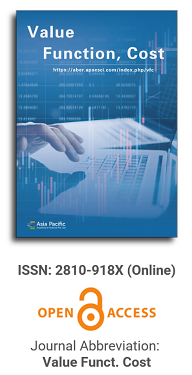
Asia Pacific Academy of Science Pte. Ltd. (APACSCI) specializes in international journal publishing. APACSCI adopts the open access publishing model and provides an important communication bridge for academic groups whose interest fields include engineering, technology, medicine, computer, mathematics, agriculture and forestry, and environment.
Research on the Relationship and Evolution of Regional Agglomeration of China's Construction Industry
Vol 3, Issue 1, 2023
Download PDF
Abstract
The research on the regional correlation of construction industry is of great significance to optimize China's construction industry structure and promote regional development. Taking 31 provinces(autonomous regions and municipalities directly under the central government) in China from 2011 to 2020 as the object, this paper studies the regional correlation and evolution of construction industry by using the methods of social network analysis and GIS spatial analysis. The research shows that: (1) in recent 10 years, there has been a social network correlation in China's construction industry agglomeration, which presents a development situation of “high in the East, low in the west, high in the South and low in the north”. (2) Beijing and Tianjin are at the core of the network of construction industry agglomeration and have strong independence. (3) China presents four distinct agglomerative subgroups.
Keywords
References
- The Development Situation of the Construction Industry during the 14th Five Year Plan Period in Our Editorial Department [J]. Installation, 2021 (05): 1-2.
- Fik T J, Mulligan G F. Spatial flows and competing central places: Toward a general theory of hierarchical interaction. Environment & Planning A, 1990, 22(4): 527-549.
- Meijers E. From central place to network model: Theory and evidence of a paradigm change. Tijdschrift Voor Economische En Sociale Geografie, 2010, 98(2): 245-259.
- BATTY M. New ways of looking at cities [J].Nature, 1995,377( 6550) :574-574.
- SHEN G. Reverse -fitting the gravity model to inter –city airline passenger flows by an algebraic simplification [J].Journal of Transport Geography,2004,12(3): 219-234.
- Matsumoto H.International urban systems and air passenger and cargo flows: some calculations. Journal of Air Transport Management, 2004,(10):241-249.
- Peter Nijkamp,Aura Reggiani. Spatial Interaction Models and Gravity Theory a Concise Overview [M]. Berlin:Springer Berlin Heidelberg,1992,2 -16.
- Cheung C,Black J. A Reappraisal of the Intervening Opportunities Model of Commuter Behaviour[J].Road and Transport Research,2008,17( 2) :3-18.
- Li Chen, Jin Xiangmu. Research on Spatial Connection Measurement of Central Towns Based on Gravity Model: Taking 25 Central Towns in Jinhua City, Zhejiang Province as an Example [J] Geographic Science, 2016 (05): 724-732.
- Miao Hongliang, Zhou Hui. A comparison of economic connections and hierarchical structures within three major urban agglomerations in China: an analysis based on the comprehensive gravity model [J] Economic Geography, 2017 (06): 52-59.
- Qi Mengxi, Lu Han, Cao Shisong, et al. Analysis of spatiotemporal evolution of economic spatial structure based on gravity model: A case study of Henan Province [J]. Geography Research, 2018 (05): 883-897.
- Dai Yong'an, Chen Cai. Spatial econometric analysis of development differences in the construction industry in China's provinces [J]. Forum on Statistics and Information, 2010, 25 (05): 53-58.
- Hong Jingke, Huang Zhijin, Yao Jiadai, et al. Research on the agglomeration and spatial spillover effects of the construction industry in the Yangtze River Economic Belt [J]. Construction Economics, 2020, 41 (12): 21-25.
- Fan Jianshuang, Yu Xiaofen. Research on the Coupling Mechanism between Construction Industry Agglomeration and Housing Industrialization [J]. China Real Estate, 2012 (22): 12-20.
- Qian Chunlei, Ye Jing, Lu Chao. A study on the division of the gravity pattern of Wuhan urban agglomeration based on an improved urban gravity model [J]. Progress in Geographic Science, 2015, 34 (02): 237-245.
- Cao Linjian, Qi Zijun, Wang Lisha. A Study on the Coupling and Synergy of Urbanization and Construction Industry Development [J]. Construction Economy, 2016, 37 (11): 87-91.
- Guangjin Tian,Zhi Qiao,Yaoqi Zhang.The investigation of relationship between rural settlement density, size, spatial distribution and its geophysical parameters of China using Landsat TM images [J]. Ecological Modelling.231(2012),25-36.
- Mi Yang, Li Ailing, Zhang Xinghua, et al. Study on the spatial distribution characteristics of provincial construction industry output value [J]. Engineering Economics, 2018, 28 (06): 48-51.
- Yang Guoan, Gan Guohui. Spatial distribution characteristics and changes of urban systems in China [J]. Earth Information Science, 2004 (03): 12-18.
- Krugman P, Venables A. Integration, specialization,and adjustment [J]. European Economic Review,1996,40( 3) : 959-67.
- Crozet M, Soubeyran P. EU enlargement and the internal geography of countries [J]. Journal of Comparative Economics, 2004, 32( 1) : 265-279.
- Li Shaolin, Xiao Xingzhi. Research on the linkage between urbanization and spatial structure of the construction industry [J]. Building Economy, 2014 (01): 12-16.
- Wang Yousong, Su Boya, Zhang Yangbing, et al. Research on the Impact of Industrial Agglomeration on Total Factor Productivity of the Construction Industry [J]. Construction Economics, 2020, 41 (12): 9-14.
- Hu Ying, Zhang Jin, Liu Zhuanhua, et al. A study on the spatial connections of urban agglomerations in the middle reaches of the Yangtze River based on gravity models and urban flow [J]. Modern Urban Research, 2016 (01): 52-57.
- Jia Nan. Research on the spatiotemporal evolution of the development level of regional construction industry in China [J]. Engineering Economics, 2019, 29 (02): 44-49.
- Zhou Xumeng. Research on the Spatial Agglomeration Effect of the Construction Industry and Its Relationship with the Development of New Urbanization [D]. Xi'an: Xi'an University of Architecture and Technology, 2018.
- Zhao Chunfeng, Yang Qingqing, Zhu Yuanyuan, et al. Spatial Connection and Spatial Organization of Hunan Regional Economy [J]. Economic Geography, 2015, 35 (8): 53-60, 67.
Supporting Agencies
Copyright (c) 2024 GENG Shan shan, ZHAO Li kun, ZHAO Peng

This work is licensed under a Creative Commons Attribution-NonCommercial 4.0 International License.

This site is licensed under a Creative Commons Attribution 4.0 International License (CC BY 4.0).
Zhibiao Gao
Nankai University, China

